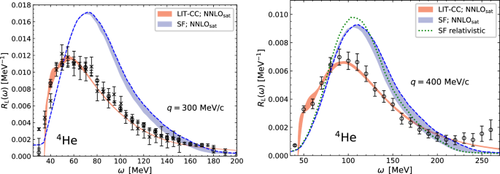Electron Scattering on \(^4\)He from Coupled-Cluster Theory
IF 1.8
4区 物理与天体物理
Q2 PHYSICS, MULTIDISCIPLINARY
引用次数: 0
Abstract
We present a coupled-cluster calculation for the electron-\(^4\)He scattering in the region of the quasi-elastic peak. We show the longitudinal and transverse responses separately, and discuss results within two distinct theoretical methods: the Lorentz integral transform and spectral functions. The comparison between them allows to investigate the role of final state interactions, two-body currents and relativistic effects.

从耦合簇理论看 $$^4$He 上的电子散射
我们对准弹性峰区域的电子-(^4\)He 散射进行了耦合-簇计算。我们分别展示了纵向和横向响应,并讨论了两种不同理论方法的结果:洛伦兹积分变换和谱函数。通过两者之间的比较,我们可以研究终态相互作用、双体电流和相对论效应的作用。
本文章由计算机程序翻译,如有差异,请以英文原文为准。
求助全文
约1分钟内获得全文
求助全文
来源期刊

Few-Body Systems
物理-物理:综合
CiteScore
2.90
自引率
18.80%
发文量
64
审稿时长
6-12 weeks
期刊介绍:
The journal Few-Body Systems presents original research work – experimental, theoretical and computational – investigating the behavior of any classical or quantum system consisting of a small number of well-defined constituent structures. The focus is on the research methods, properties, and results characteristic of few-body systems. Examples of few-body systems range from few-quark states, light nuclear and hadronic systems; few-electron atomic systems and small molecules; and specific systems in condensed matter and surface physics (such as quantum dots and highly correlated trapped systems), up to and including large-scale celestial structures.
Systems for which an equivalent one-body description is available or can be designed, and large systems for which specific many-body methods are needed are outside the scope of the journal.
The journal is devoted to the publication of all aspects of few-body systems research and applications. While concentrating on few-body systems well-suited to rigorous solutions, the journal also encourages interdisciplinary contributions that foster common approaches and insights, introduce and benchmark the use of novel tools (e.g. machine learning) and develop relevant applications (e.g. few-body aspects in quantum technologies).
 求助内容:
求助内容: 应助结果提醒方式:
应助结果提醒方式:


